
The Peter and Paul Fortress is one of the most interesting and oldest architectural monuments in St. Petersburg.
The Peter and Paul Fortress is located in the center of St. Petersburg on Zayachy Island.
After the battle with the Swedes during the Northern War, when Russian troops recaptured the land at the mouth of the Neva River (the fortress of Nienschants), the question arose about their protection. It was decided to build a fortress, the location of which was the widest part of the Neva River - where the Hare Island, whose name comes from the Finnish "Jänissaari", was located.
The Peter and Paul fortress was conceived by Tsar Peter I and the date of its foundation is 16 (27 in the new style) May 1703, which is also considered the day of the foundation of St. Petersburg.
The design of the fortress was sketched by Peter I himself, and the first plans were drawn up in 1703 by the Saxon engineer Wilhelm Adam Kirshtenstein and the French engineer Joseph Gaspard Lambert de Guerin.
On June 29, on St. Peter's Day, the wooden church of the Holy Apostles Peter and Paul was laid on the island. This event was marked by the firing of cannons. Today, the Peter and Paul Cathedral stands on the site of this church.
Initially, the defensive structures of the fortress (bastions, ramparts, ravelin, kronverk), including to save time, were built of wood and earth (wood-earth fortifications).
Since May 1706, the replacement of the wooden-earth fortifications of the fortress with stone (brick) ones began.
In 1779-1785, as the brick walls of the fortress began to collapse due to the river waters and the climate, the part of the Peter and Paul Fortress facing the Neva River was faced with granite slabs.
Also on the territory of the fortress, food warehouses, ceyhouses, residential buildings and other buildings were erected; another ravelin, several gates and a kronverk with an arsenal also appeared.
In the entire history of the Peter and Paul Fortress was not used in any battle. From the first quarter of the 18th century until the early 1920s, the fortress served mainly as a prison, and since 1924 it has been a state museum.
Today, the Peter and Paul Fortress is not only one of the most popular museum complexes, but also the pearl of the city and is listed as a UNESCO World Heritage Site.
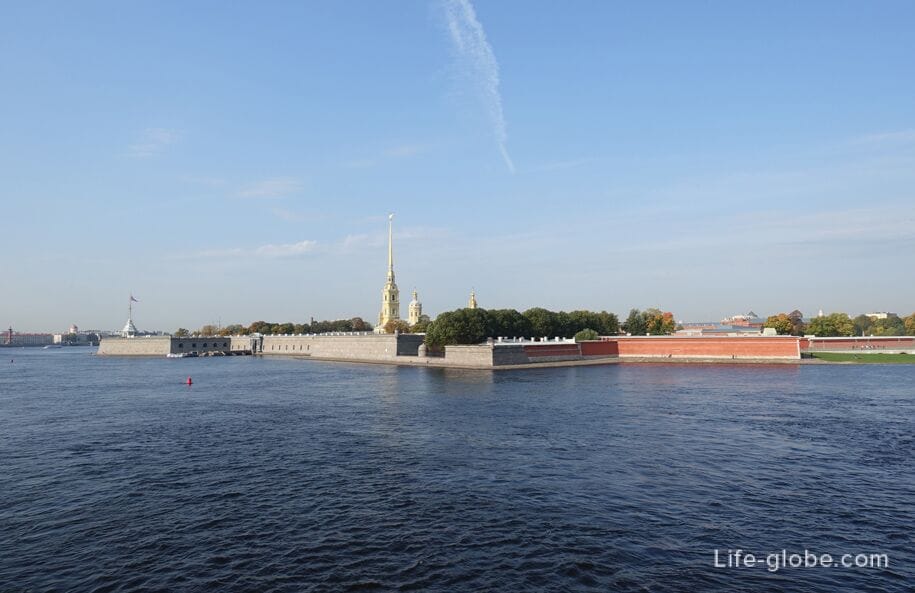
The Peter and Paul Fortress is a complex of historical buildings, which are surrounded by curtinas, bastions and ravelins (former defensive structures).
In the premises of the fortress there are museums and expositions, souvenir shops and a couple of cafes.
In its external structure, the Peter and Paul Fortress contains
1. Six bastions - defensive structures that protrude beyond the walls of the fortress.
The bastions were built under the supervision of Peter I, as well as his associates, who acted as curators of the construction: Alexander Menshikov, Kirill Naryshkin, Yuri Trubetskoy, Gavriil Golovkin and Nikita Zotov.
According to the names of the companions, the bastions got their names: Naryshkin Bastion, Trubetskoy Bastion, Zotov Bastion, Golovkin Bastion and Menshikov bastion.
Another one - the sixth bastion, but not in importance, named after Peter I - is The Gosudarev bastion, from which the construction of the fortress began.
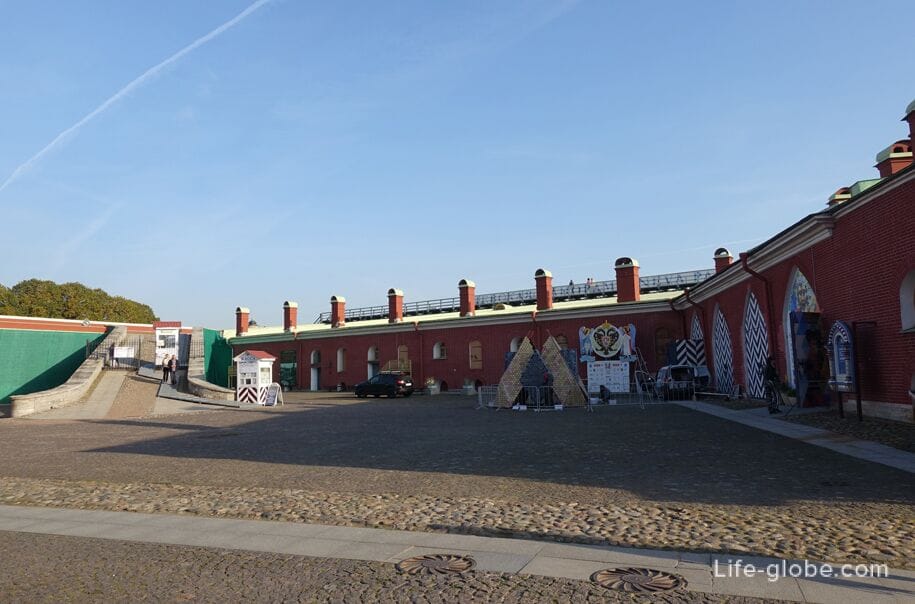
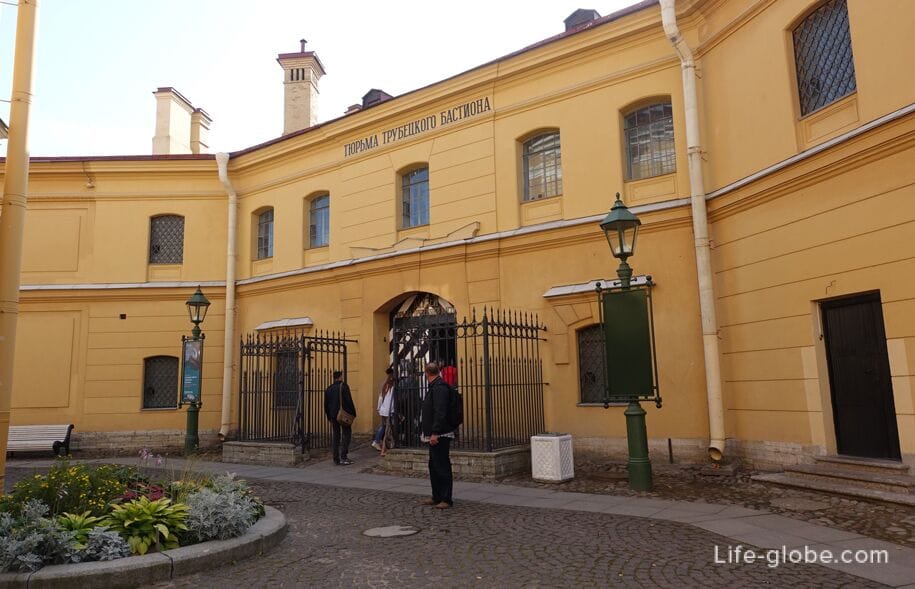
The most interesting of the bastions is, perhaps, Naryshkin Bastion, because:
- Every day, the bastion is the site of a symbolic noon (at 12:00) cannon firing ceremony.;
- on the bastion there is a voluminous Flagpole tower, built in 1731-1733 by the project of the military engineer B.-X. Minich. Learn more about Naryshkin Bastion and Tower…

2. Six curtain walls - sections of the fortress walls that run between the bastions and, together with them, were an inseparable defensive structure surrounding the fortress buildings.
Curtinas have casemates, which at various times were adapted for barracks, apartments, warehouses of food and construction materials, as well as for prison premises.
The gates of the fortress are located in five of the 6 curtinas.
Curtains and gates:
- Peter's Curtain, connecting Menshikov and Gosudaryov bastions.
The Peter's Gate, which is the main main entrance to the fortress and is dedicated to the glorification of Russia's victories over Sweden in the Northern War, is located in the curtin.
Starting to the left of the Peter's Gate and inside the wall of the Sovereign's Bastion for a distance of about 150 meters, ending in the casemate, passes the former poterna (secret passage), which is open today and where various exhibitions and events are held.
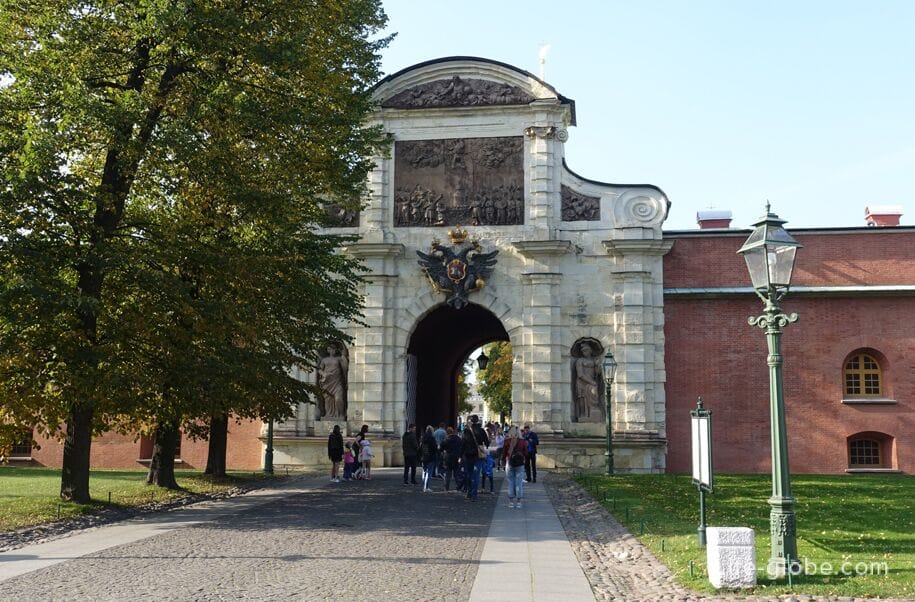
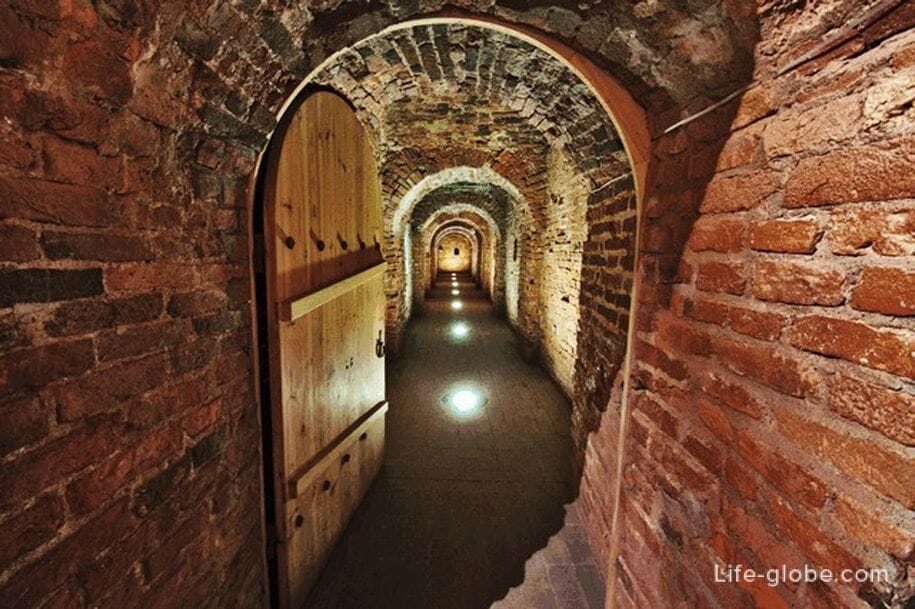
- The Neva curtainconnecting the Gosudaryov and Naryshkin bastions.
In Kurtin there is the Neva Gate, which leads from the fortress to the waters of the Neva - a granite three-arched pier with steps, to which tourist boats dock.
Once upon a time, prisoners of the prison were brought to this pier, through the Nevsky Gate, at night, from where they were sent to hard labor or execution by water. For this reason, this gate was popularly called the "Gate of Death".
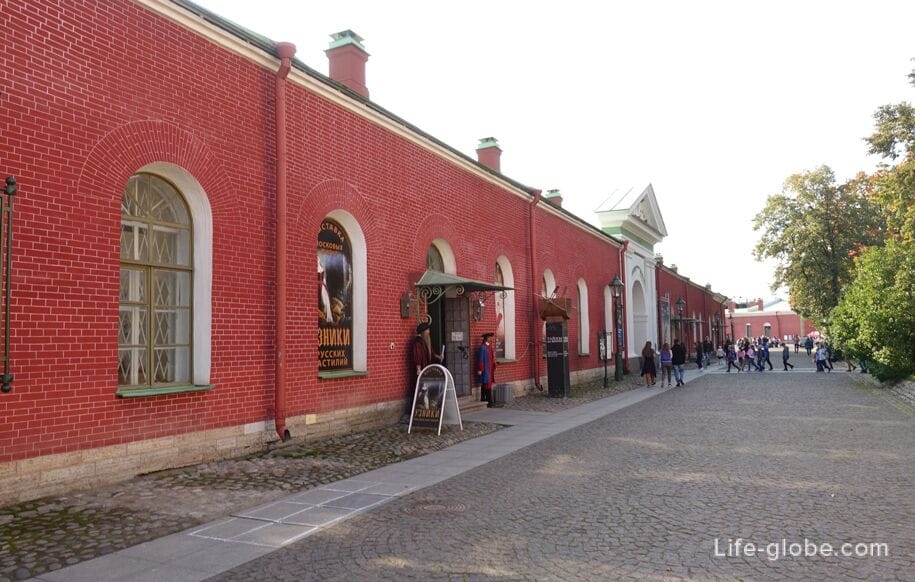
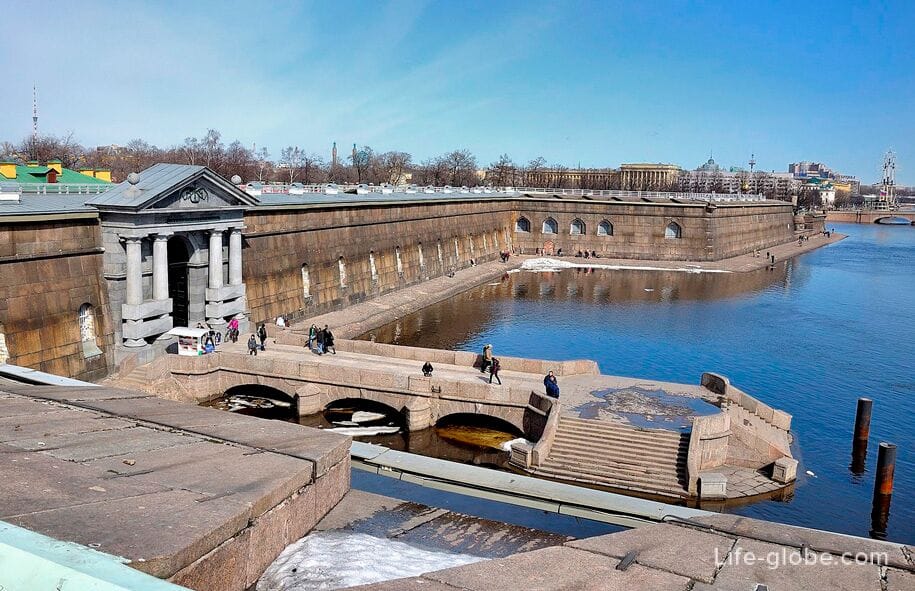
- Catherine Curtainwall, connecting Naryshkin and Trubetskoy bastions. Learn more about Catherine's Curtain…
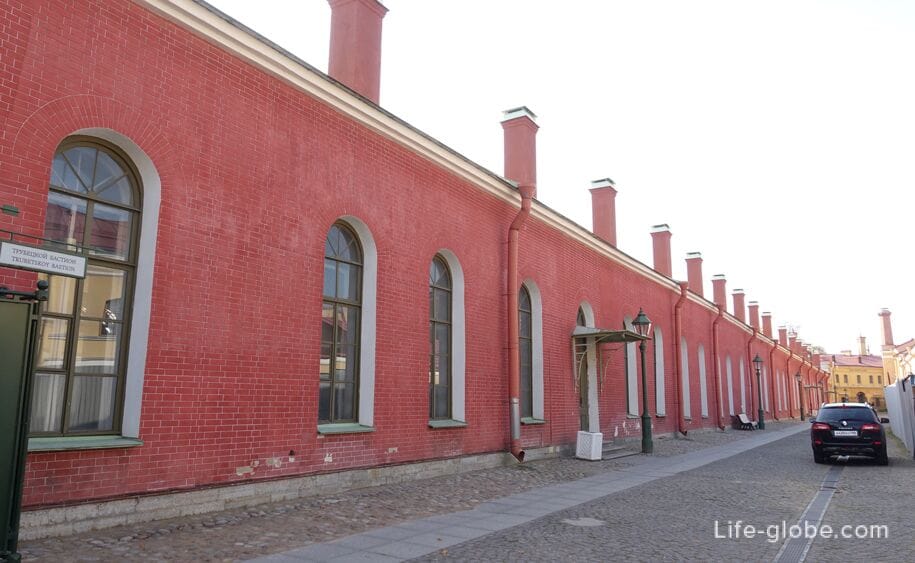
- Vasilyevskaya curtainwall, connecting Trubetskoy and Zotov bastions.
In the Vasilyevskaya Curtin there are Vasilyevsky Gates, which are decorated from the outside with double pilasters and a triangular pediment. Learn more about Vasilyevskaya Kurtina and the gates…
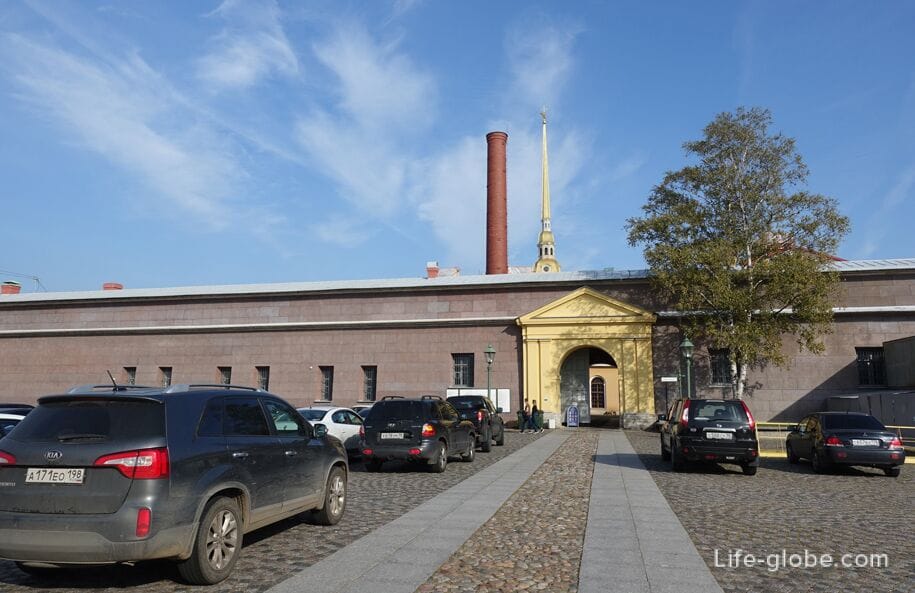
- The Nikolskaya Curtainwall connecting the Zotov and Golovkin bastions.
In the Nikolskaya Curtin there is the Nikolsky Gate, the facades of which are decorated in Neo-Renaissance forms. Learn more about Nikolskaya Curtin and the gates…
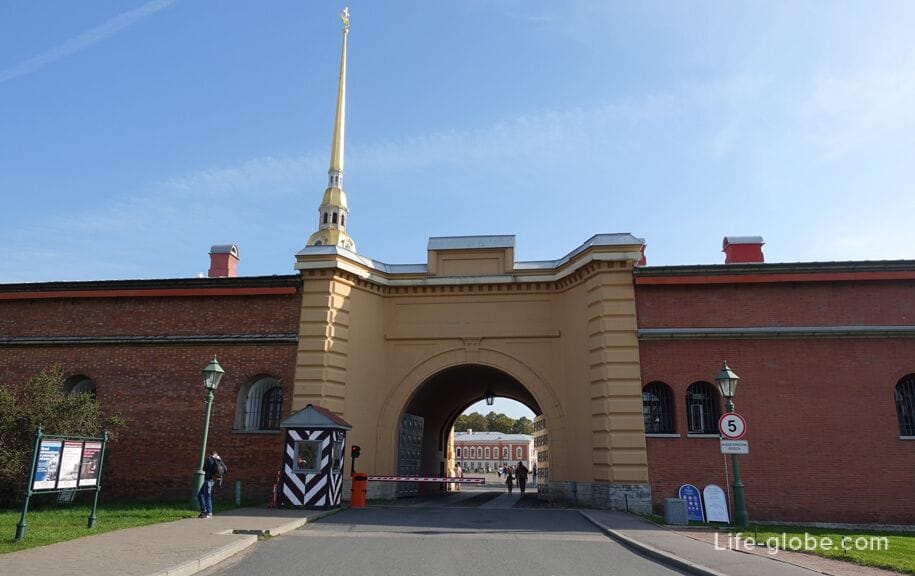
- The Kronverk curtainwall connecting the Golovkin and Menshikov bastions.
In the Kronverk Curtain there are the Kronverk Gate, which is the most inconspicuous of all the gates of the Peter and Paul Fortress - they are extremely simple and, as a rule, closed to the passage.
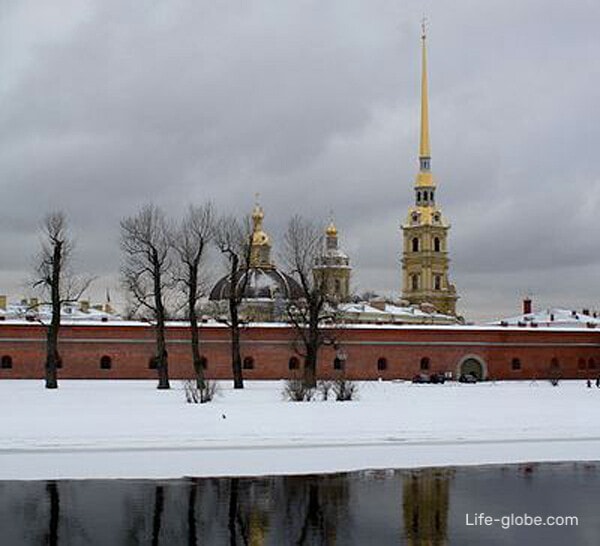
3. Two ravelins: Ioannovsky and Alekseevsky-former auxiliary defensive structures erected on the eastern and western sides of the fortress, intended to cover the bastions, fortress walls and gates.
In front of the ravelins were the fortress water ditches, which are now filled in.
The most visited is the St. John's Ravelin, where the St. John's Gate is located, through which most of the guests enter the fortress.
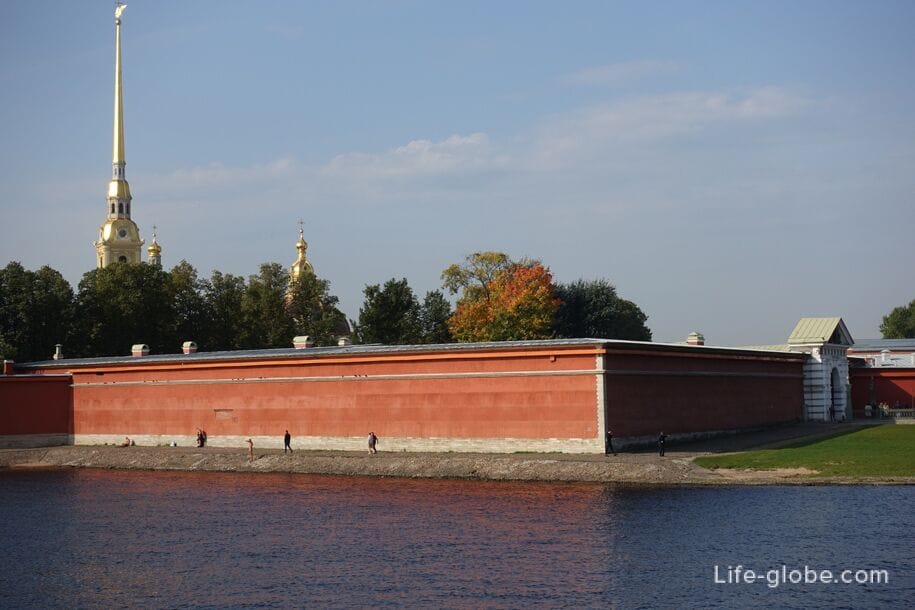
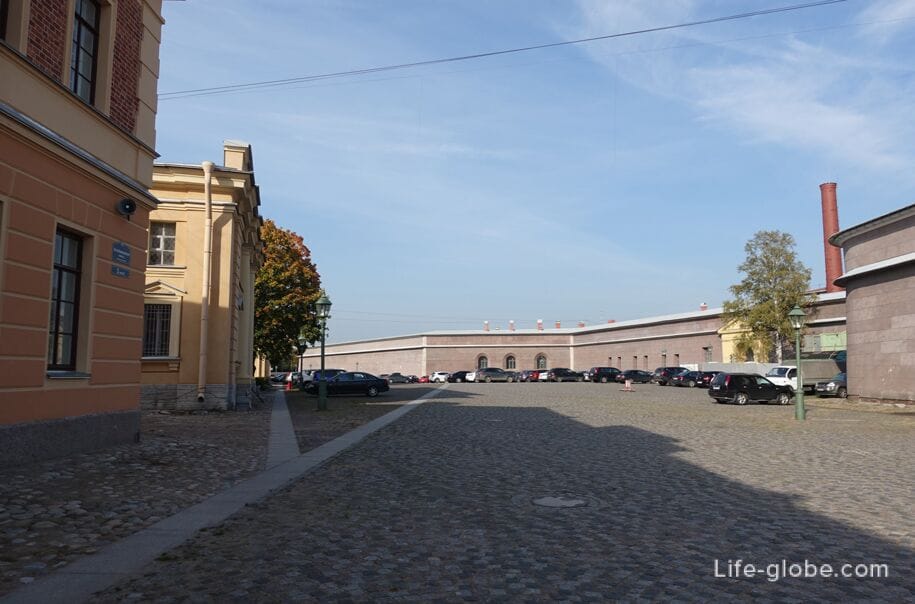
4. Beach and green area.
On the southern side of the fortress walls, near the waters of the Neva River, there is a beach of the Peter and Paul Fortress.
On the north side, behind the walls and bastions, there is an extensive green area, where there is a helipad and car parking, and the place is also used for large-scale "open air" and corporate events.
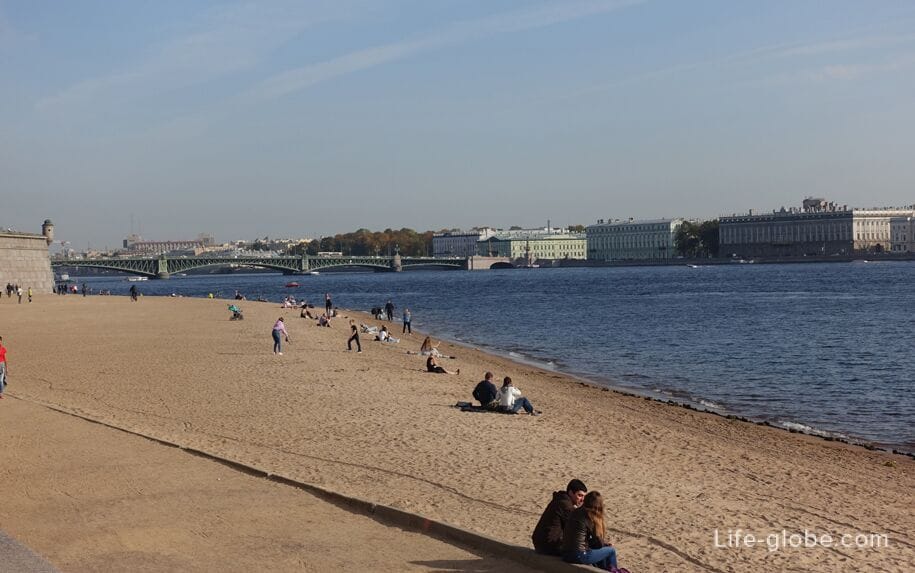
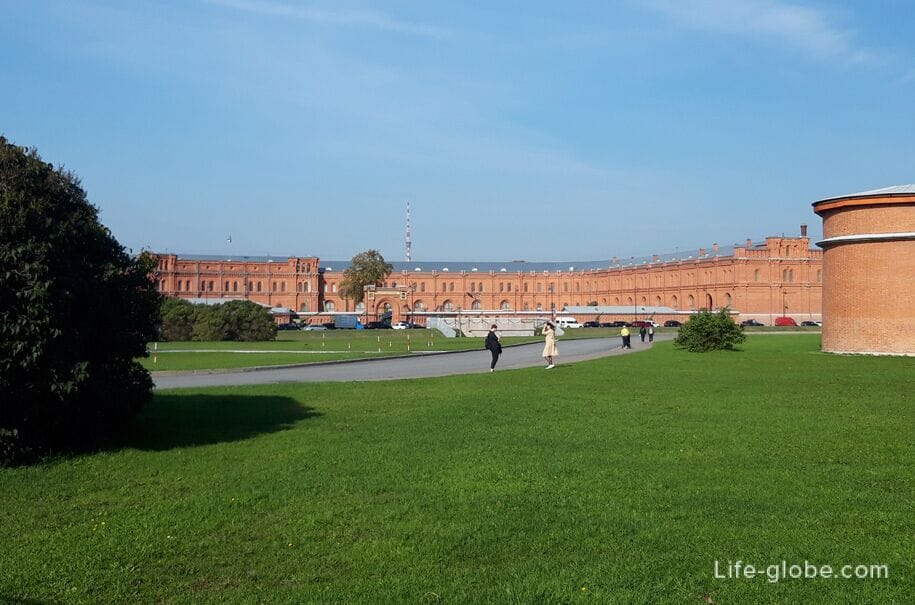
5. Kronverk and arsenal.
On the northern side of the fortress, behind the Kronverksky Strait, there is a kronverk with an arsenal and glacis, which were also an integral part of the Peter and Paul Fortress, but are perceived separately, since they are not located on Zayachy Island, but on the Petrograd side.
Today, the Kronverk arsenal houses the military-historical museum of artillery, engineering troops and signal troops. Museum website: artillery-museum.
In the courtyard, to the right of the museum building next to the Kronverk Canal, there is an obelisk to the Decembrists, who were executed at this place in 1826.
On the site of the glacis, Alexander Park was laid out.
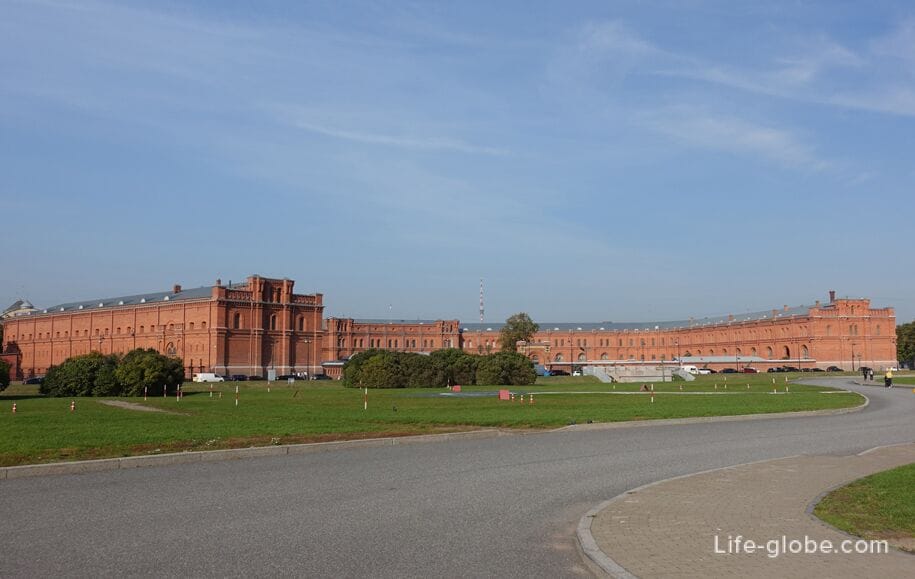
6. Cavalier of Anna Ioannovna (Anninsky).
Inside the Golovkin bastion there is a former auxiliary structure built above its walls, for additional protection of the Kronverk with artillery fire and for organizing independent defense in case of enemy penetration into the fortress.
The cavalier was adapted as an artillery depot and storage of war trophies.
Today, the cavalier is managed by the State Enterprise "St. Petersburg Mint" and within its walls there is a museum of the "History of Money".
Museum website: museum.goznak.
Internal structure of the Peter and Paul Fortress
Inside the walls of the Peter and Paul Fortress there are various historical buildings, including:
- Peter and Paul Cathedral with the Grand-Ducal Tomb, which are the main dominants in the fortress and in which the crowned representatives of the Russian Imperial House, grand dukes and princesses, as well as members of families related to the Romanovs are buried.
The Cathedral and the Grand-Ducal Tomb function as a single museum, which has a paid entrance fee. Read more about the Peter and Paul Cathedral with the Grand Ducal Tomb…
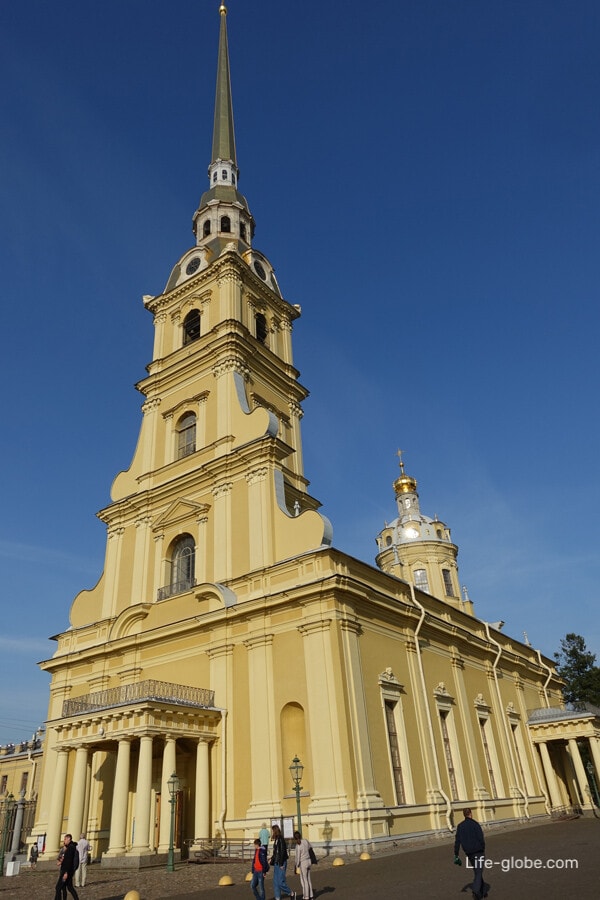

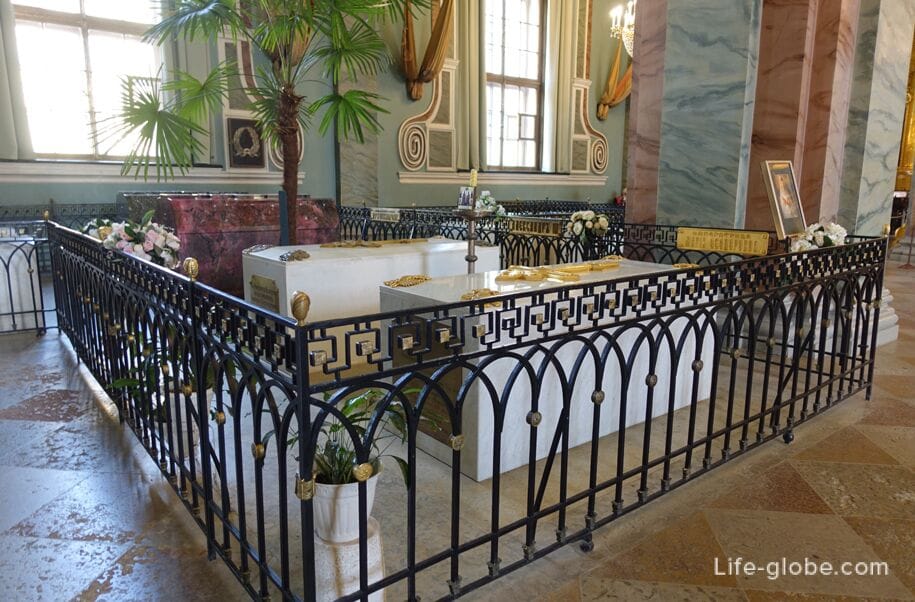
- The Commandant's Cemetery, located near the Grand Ducal Tomb and behind the Peter and Paul Cathedral. This is one of the oldest cemeteries in St. Petersburg.
The cemetery contains the ashes of the commandants of the Peter and Paul Fortress, who died at their post.
The first funeral ceremony at the cemetery took place in 1720 in the presence of Peter I - the funeral of a close associate of the tsar, Lieutenant General of the Russian army R. V. Bruce.
The last burial was made in 1914 - the general from the infantry, Adjutant General V. N. Danilov.
The cemetery is laid out on three levels, corresponding to the chronology of the burials: the 18th-century tombstones are located in the center on the lowest level; the 19th-century burials are located on the middle level in the southern part of the cemetery; the 20th-century graves are located on the modern level, in the north-western part of the cemetery;
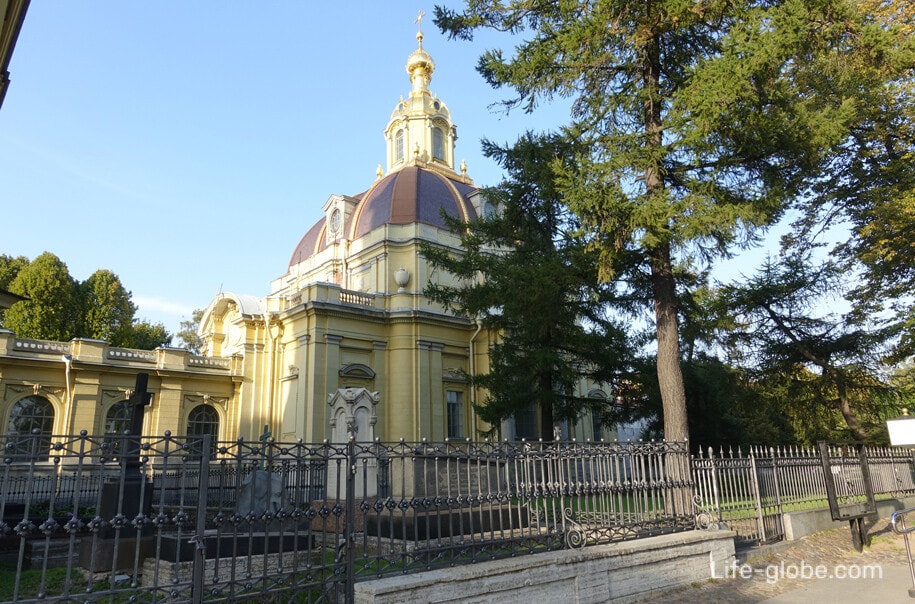
- the building of the Mint with a complex of buildings is one of the oldest industrial enterprises in St. Petersburg, which has been located in the Peter and Paul Fortress since 1724;
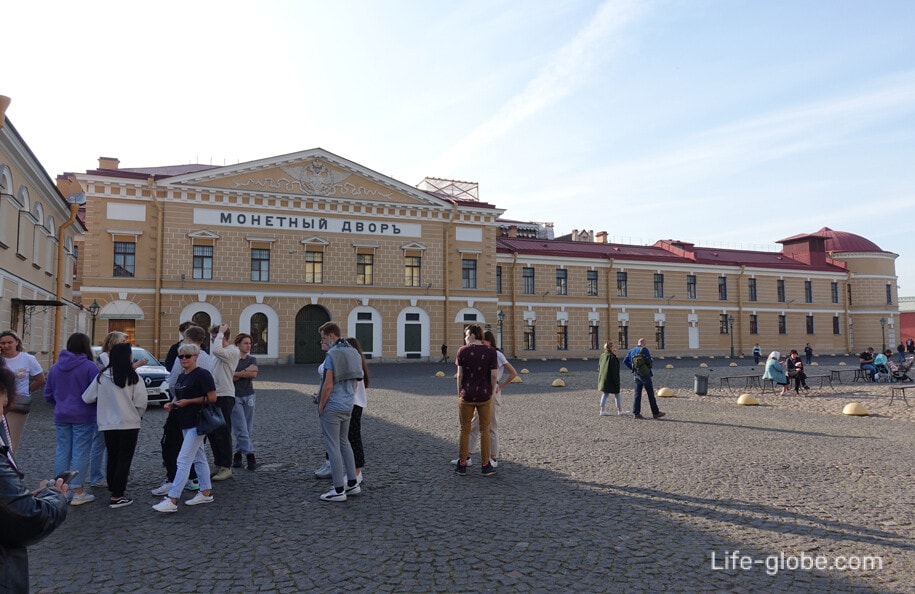
- Botny Dom - a small building (pavilion), built in 1762-1765 by the architect of German origin Alexander Frantsevich Vista to store the national relic (ship) - the boat Peter 1, which is known as the"Grandfather of the Russian Fleet".
Today, the place of the "Grandfather of the Russian Fleet" in the Botny House is occupied by its exact copy-a reconstruction model created in 1996-1997 to mark the 300th anniversary of the creation of the Russian Fleet. Entrance to the Bot House is free (free of charge). Learn more about the Bot House and the bot house…
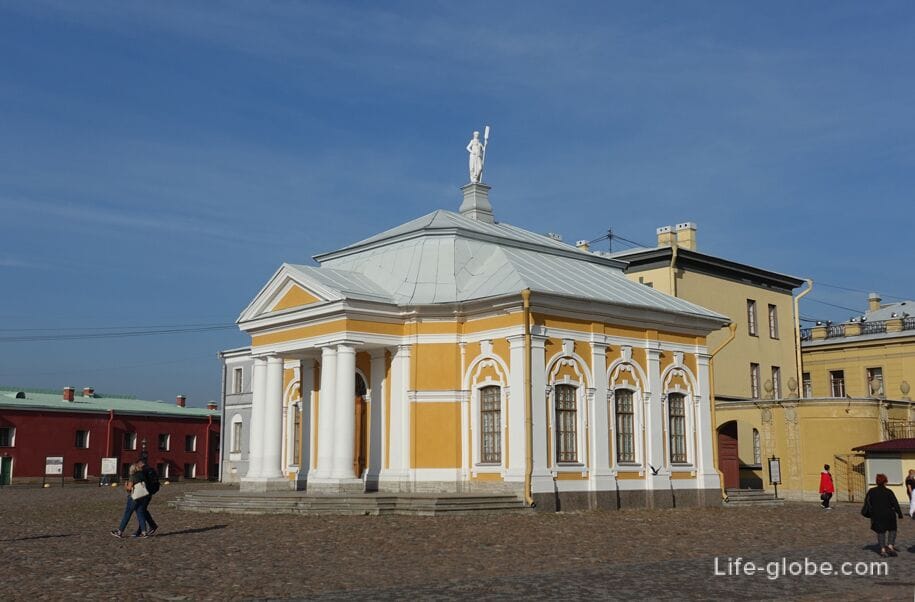
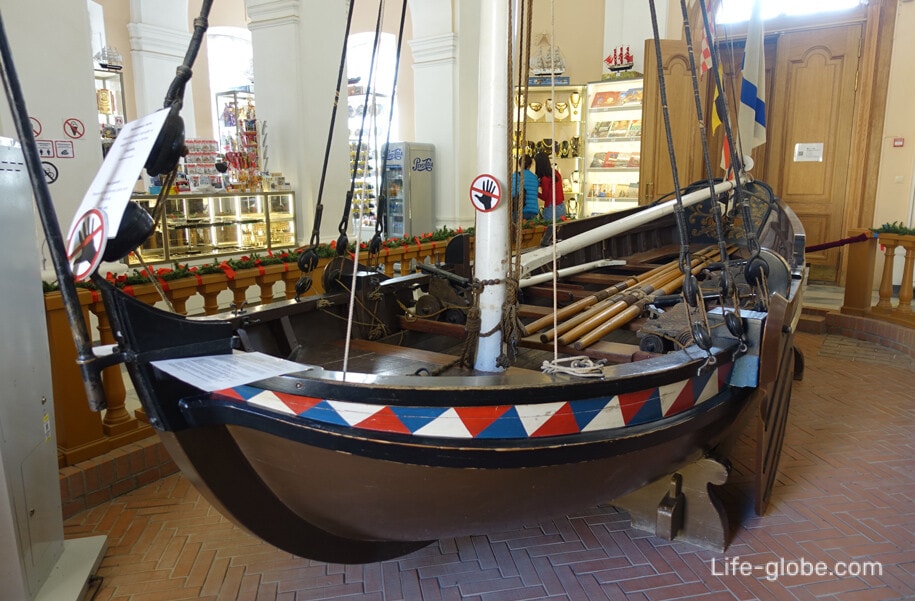
- the house of stock capital, built in 1843-1844 according to the project of A.M. Kutsi to store the monetary fund that provided state credit cards;
- the commandant's house, built in 1743-1746, and where the front and living quarters of the commandant of the fortress garrison were located, as well as the house church. Learn more about the commandant's house…
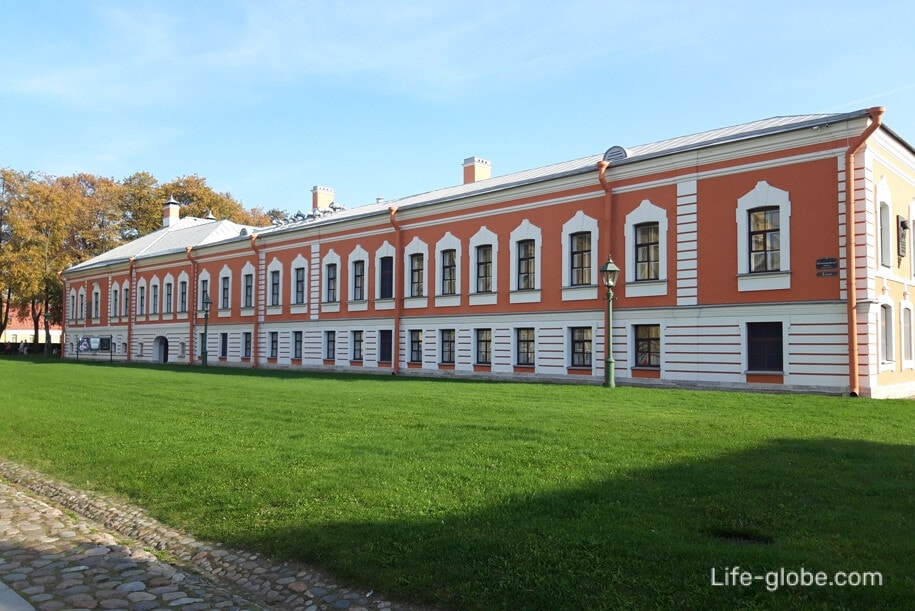
- the carriagehouse, erected in 1846, and used as the building of the commandant's office. The structure also included a stable with six stalls, two carriage sheds for storing carriages and carriages, a covered courtyard with a manure pit, and a glacier. Learn more about the carriage house…
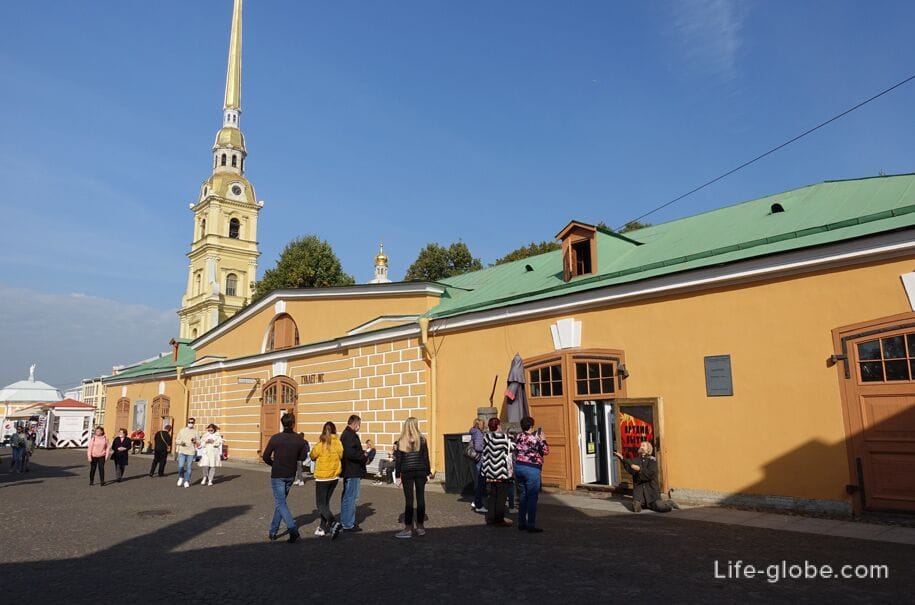
- Ober-officer's guardhouse, built in 1748-1749 to house the Main Garrison Guard and keep the arrested officers and lower ranks.
The territory in front of the guardhouse, which today is a green zone, was called "Dance". This name is associated with the procedure for punishing soldiers - in the 18th century, in the square in front of the guardhouse, there was a post around which sharp spokes were driven into the ground; the whole device was called a "perch". The soldier was tied to a post barefoot, so that his feet reached the spokes; and from the pain of the soldier was often forced to move his feet, which from a distance looked like a dance. Learn more about the guardhouse…

- Engineering house, built in 1748-1749 and has survived almost unchanged.
At various times, the Engineering House housed the drawing workshop and the Technical building of the Engineering Team, which was engaged in carrying out repair and construction work in the fortress; the archive of the Engineering Department and living quarters for employees of the Engineering Department. Learn more about the Engineering House…
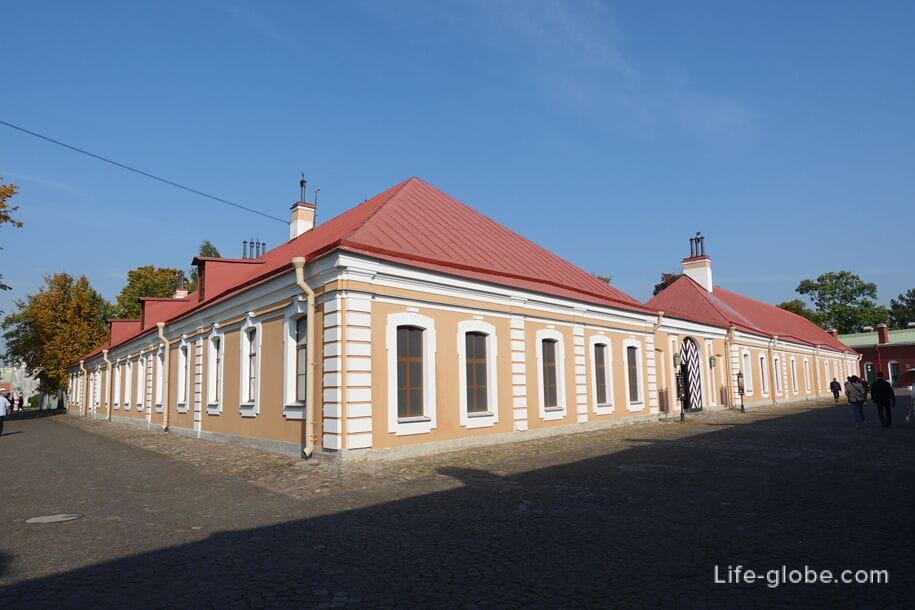
- Artillery zeichhaus, built in 1801-1802 by the military engineer Alexander Briskorn to store weapons and military equipment.
At various times, the building housed: a fire station, a telephone exchange, prison cells, workshops, and the Society for the protection of monuments of the Leningrad Region. Learn more about the Zeichhaus…
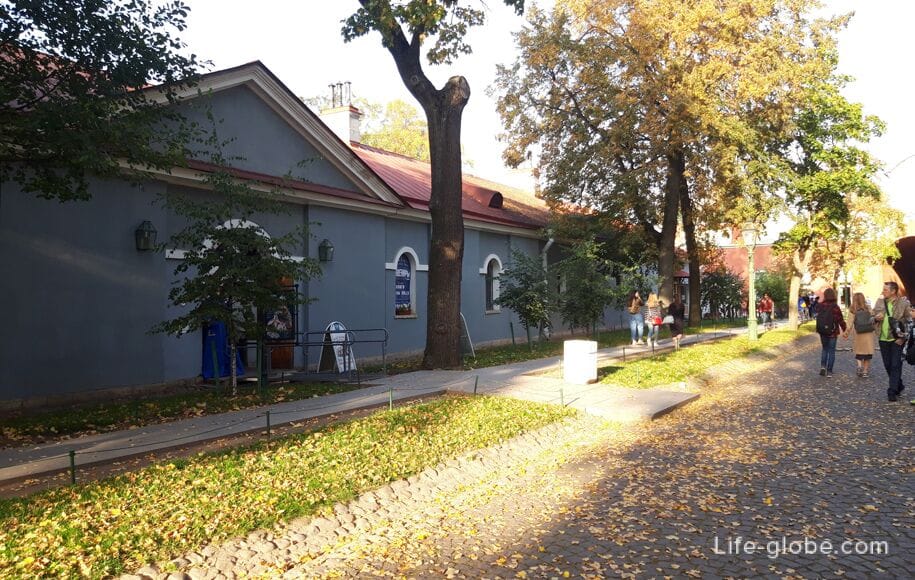
- the Main Treasurybuilding, built in 1837-1838 by the architect I. I. Galberg to house the Main Treasury and store the finished products of the Mint. In 1900, according to the project of the military engineer V. F. Asmus, the building of the boiler house, laundry and workshops of the fortress garrison was added to the building.
Currently, the listed premises of the Peter and Paul Fortress are museums and expositions, exhibition and service premises.
The buildings and defensive structures of the fortress are managed by the State Museum of the History of St. Petersburg and, a small part, by the State Enterprise "St. Petersburg Mint".
The fortress is located about 15 museums, most of which relates to the State Museum of history of St. Petersburg: Museum of science and technology, Museum of cosmonautics and rocket technology. V.P. Glushko, a Museum of architectural art ceramics, the prison of Trubetskoy Bastion, the exhibition "the History of Peter and Paul fortress", the exhibition "the History of St. Petersburg - Petrograd. 1703-1918" and the exhibition "The Subject world of Modernity".
!!! To all the seven listed museums + to the Peter and Paul Cathedral with the Grand Ducal Tomb (total: 8 objects of the fortress) - you can buy separate tickets for each of the expositions or to the museum, or a complex ticket to visit all the above-mentioned museums and expositions of the Peter and Paul Fortress.


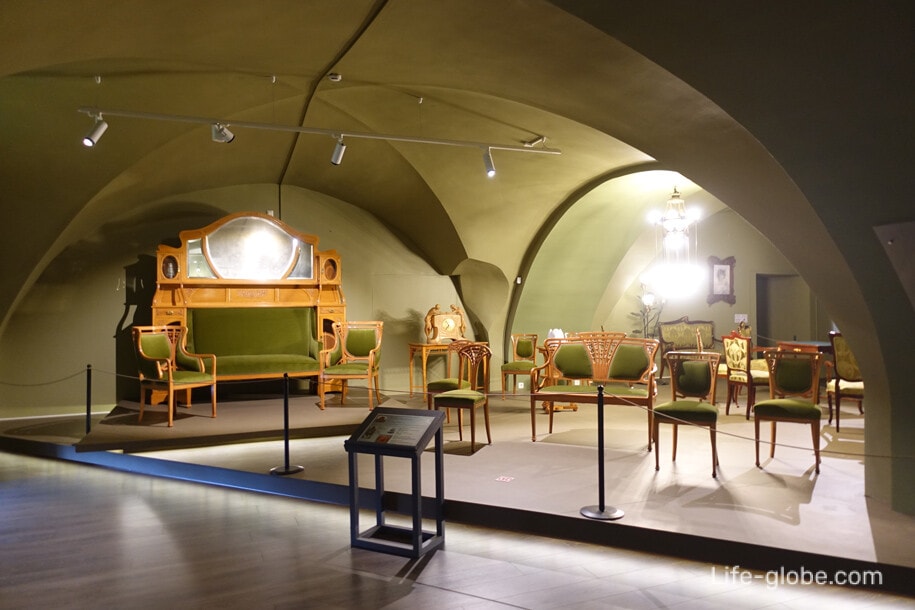
In addition to these, there are other exhibitions and expositions on the territory of the fortress. For example, the collection of porcelain and glass of the 18th and 21st centuries, the exhibition " Inquisition. Medieval instruments of torture", an exhibition of wax figures "Historical mosaics", etc.
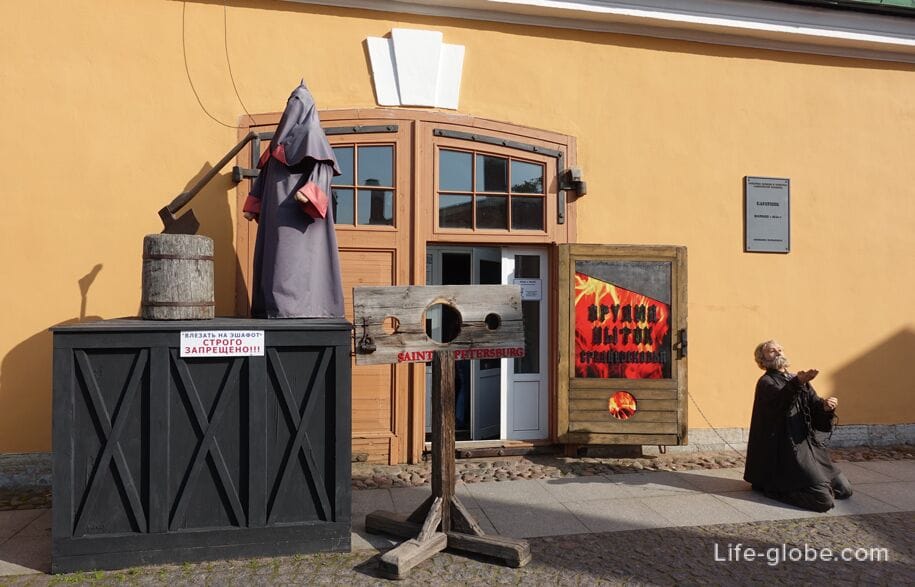
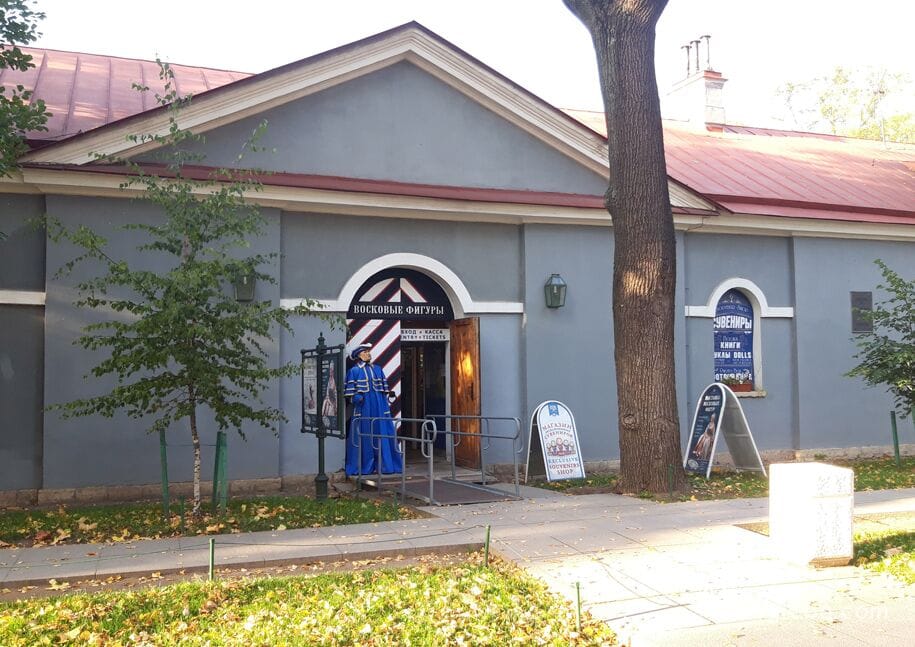
Temporary (rotating) exhibitions and exhibitions are regularly held in the fortress. As well as various events and festivals. Learn more about all museums and exhibitions in the Peter and Paul Fortress…
On the territory of the Peter and Paul Fortress there are two viewing platforms:
- The Neva Panorama is a sightseeing walking route that runs along the roofs of the former fortifications of the Peter and Paul Fortress.
The walking route "Nevsky Panorama" has a length of 300 meters and is laid on wooden bridges on the roof of the former fortress wall of the Peter and Paul Fortress-the Neva curtain: from the Gosudarev to the Naryshkin bastions.
The route offers panoramic views of the Peter and Paul Fortress itself, the Neva River and part of the historical center of St. Petersburg, including: The Palace Embankment with the Winter Palace, the Arrow of Vasilievsky Island, Troitsky and Palace bridges, which are drawbridges, and St. Isaac's Cathedral and The Admiralty.
A visit to the Nevskaya Panorama sightseeing route is possible for a fee. Learn more about the Nevsky Panorama…
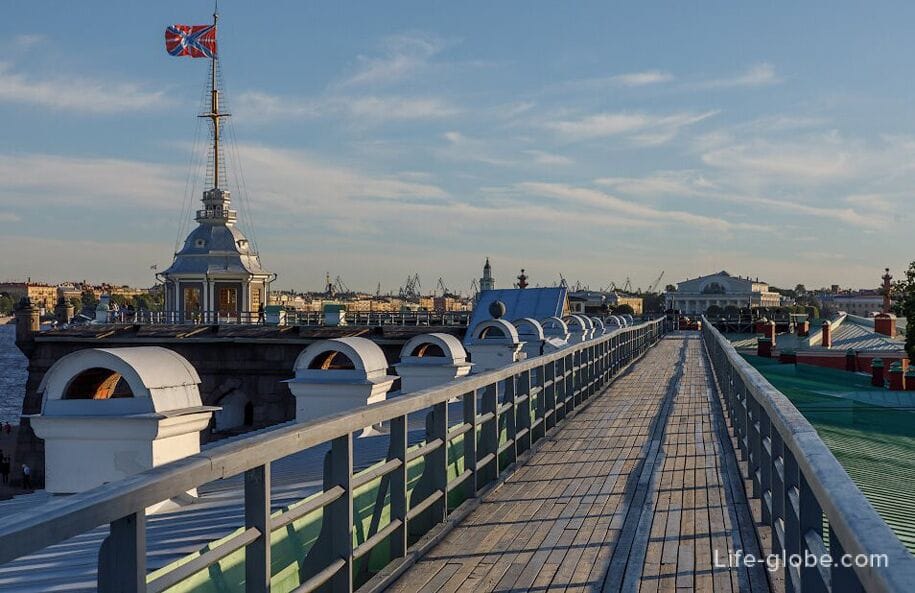
- an observation deck in the bell tower of the Peter and Paul Cathedral, which can be visited for a fee with the excursion route "Three Centuries above the City".
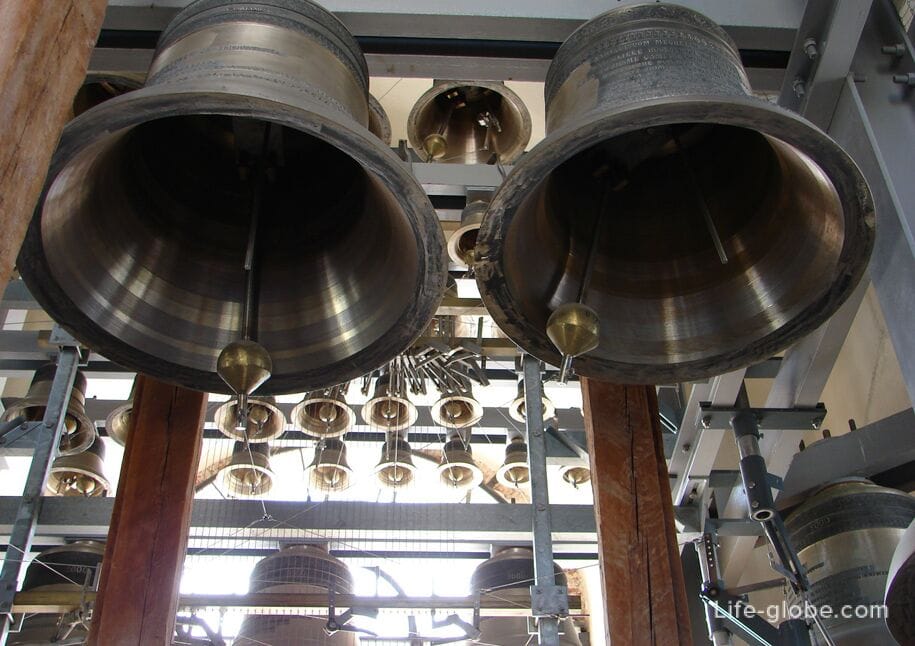
In addition to the buildings on the territory of the Peter and Paul Fortress, several shady alleys are laid out, there is a main square, a small square, there are also places for recreation, lanterns, urns, souvenir shops and a couple of cafes and eateries.

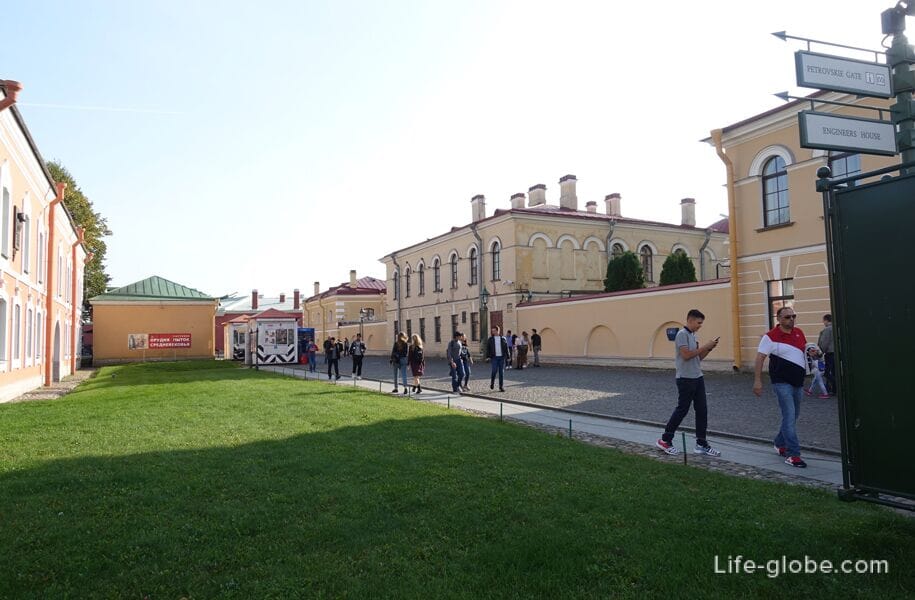

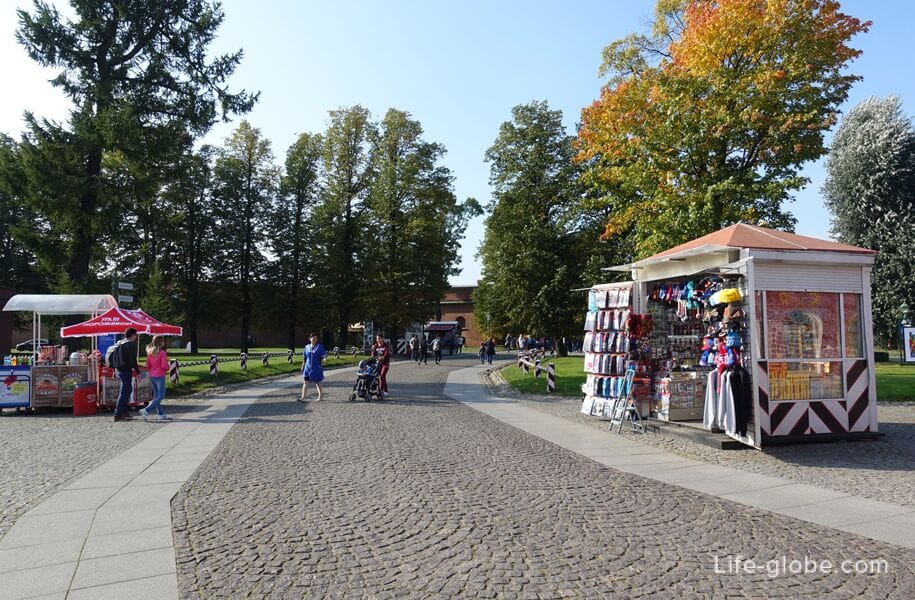
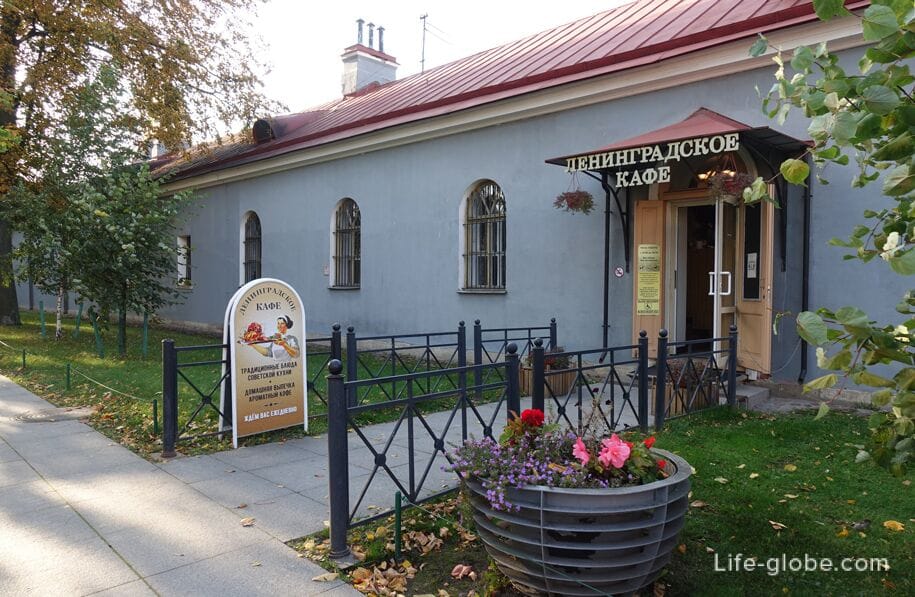
Since the Peter and Paul Fortress is located on Zayachy Island, many sculptures of hares can be found on its territory , and live rabbits live near the southern tip of the inner part of the Ioannovsky Ravelin.
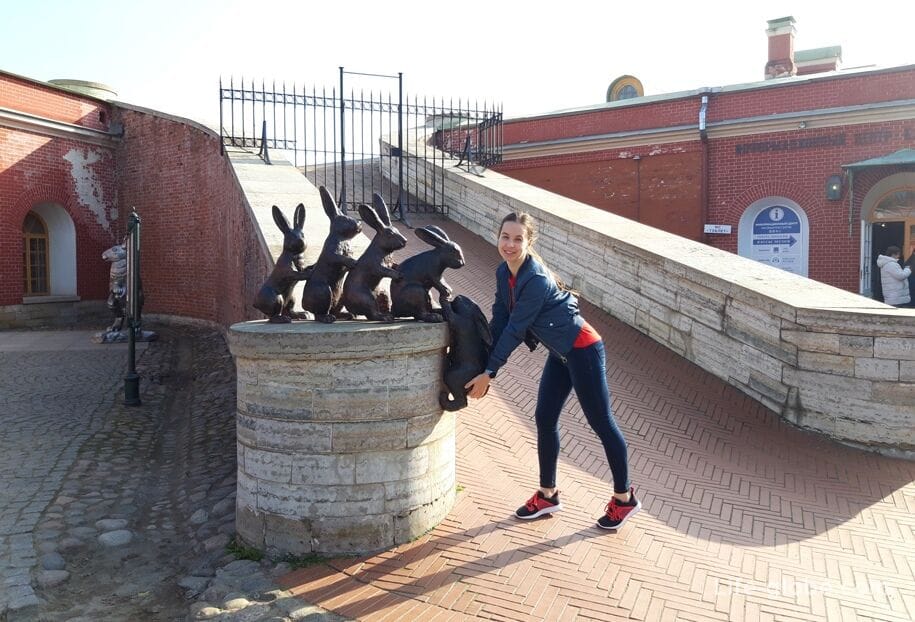
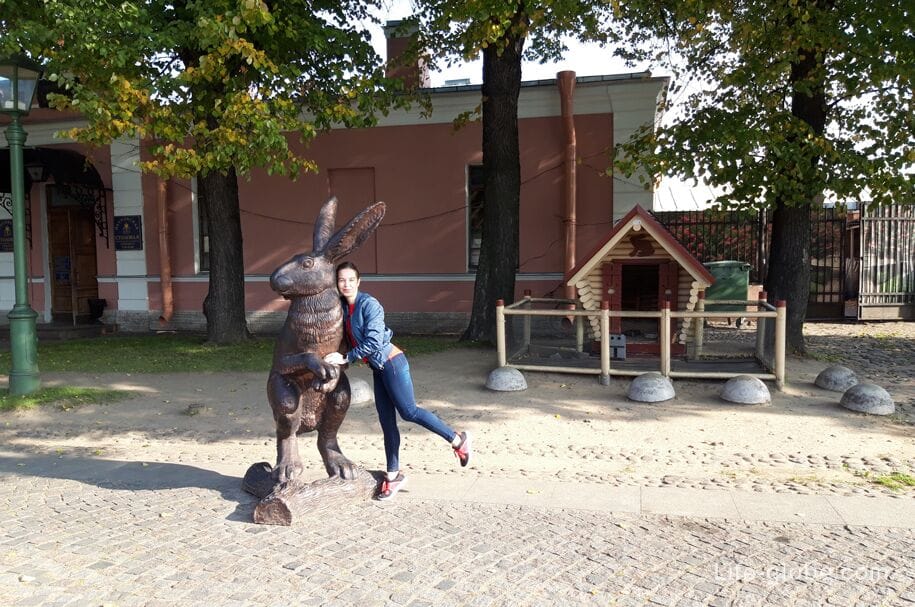
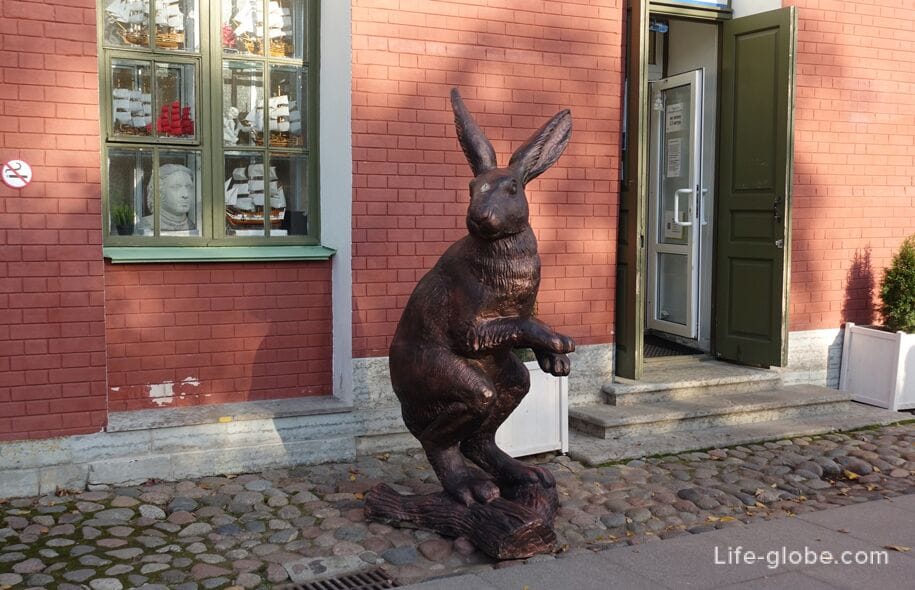
Main Alley The Peter and Paul Fortress stretches from the Peter's Gate to the Peter and Paul Cathedral.
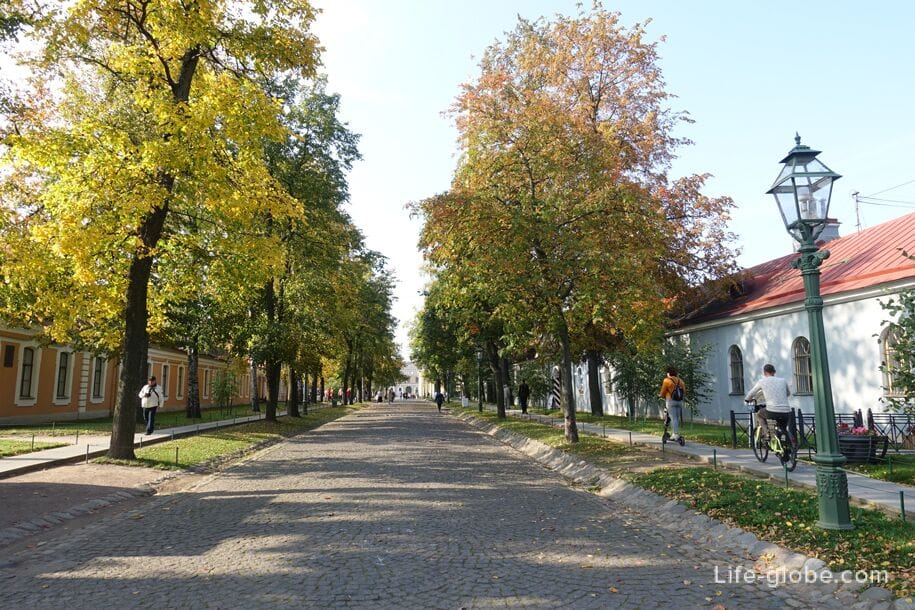
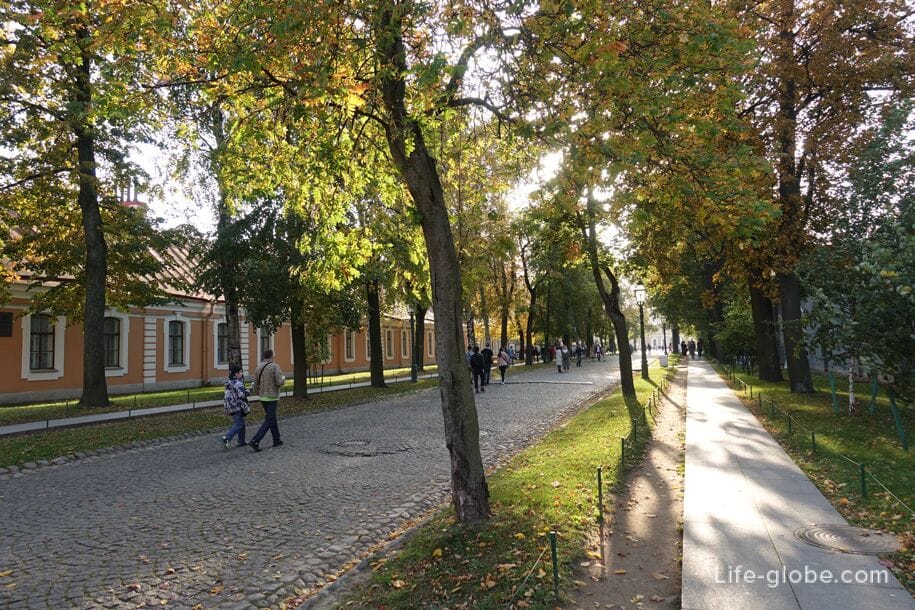
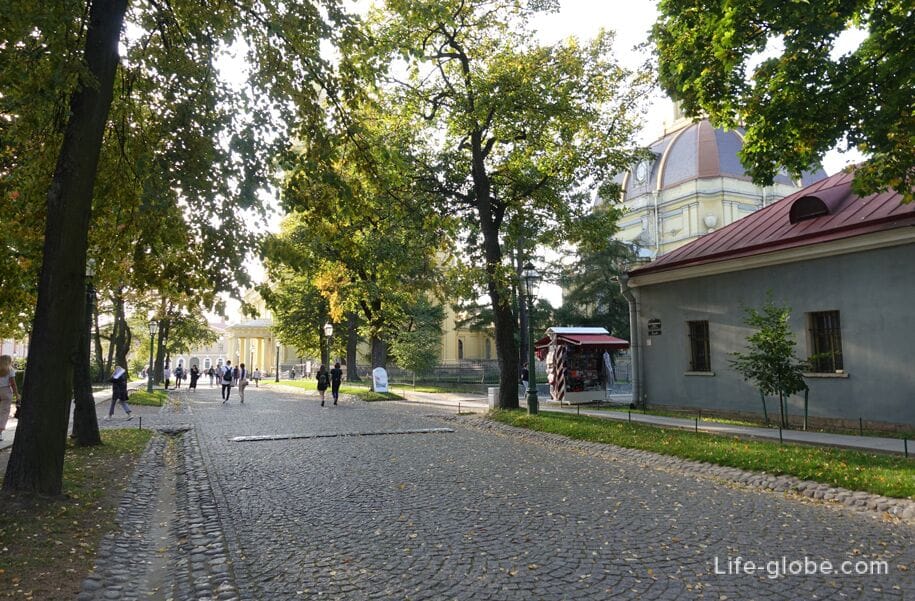

On the alley, in front of the main facade of the former guardhouse, there is a bronze monument to Peter I, made by the sculptor Mikhail Shemyakin. The monument was erected in 1991.
The proportions of the figure of Peter the Great depicted in the monument are non-standard, since the sculptor, creating life-size models of the monument from clay, found out that the figure of Peter turned out to be nondescript - Peter I was represented by a short man. Then the master began to increase the proportions of the body of Peter I, without changing the size of the head (made with a death mask), and thus came to the proportions of Russian icons.

The main square of the Peter and Paul Fortress, which is calledCathedral Square is the heart of the fortress, surrounded by such dominates as the Peter and Paul Cathedral, the Botny House and the Mint building. Learn more about Cathedral Square…
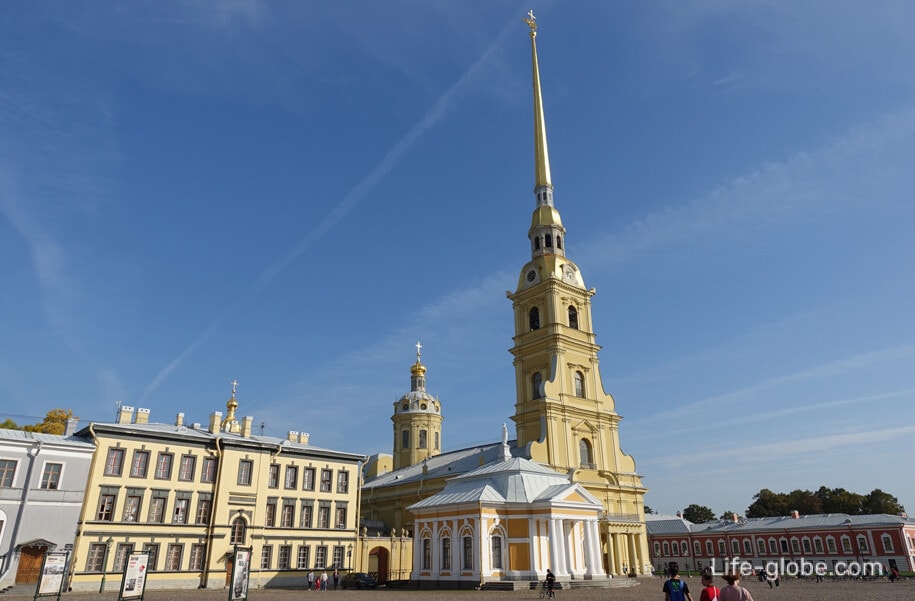
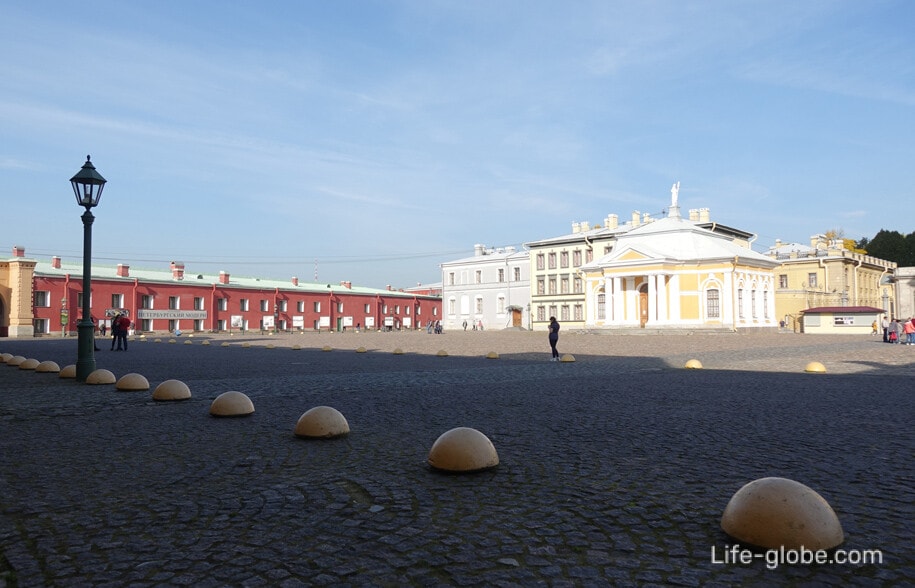
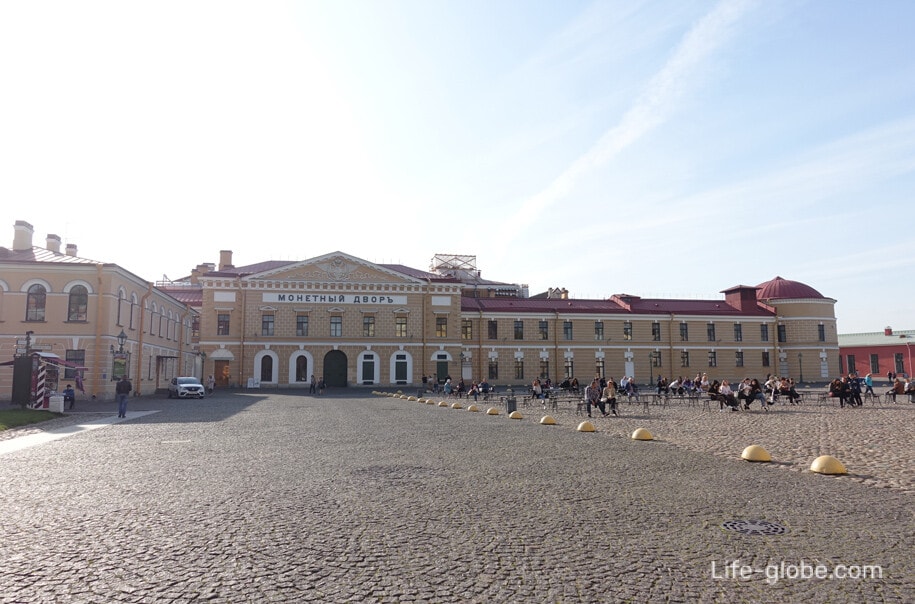
A small green area (square) is located between the Naryshkin Bastion and the Commandant's House. There are notable forged genre sculptures "Sundial Time of the master", "12 Chairs" and "Tree-globe".
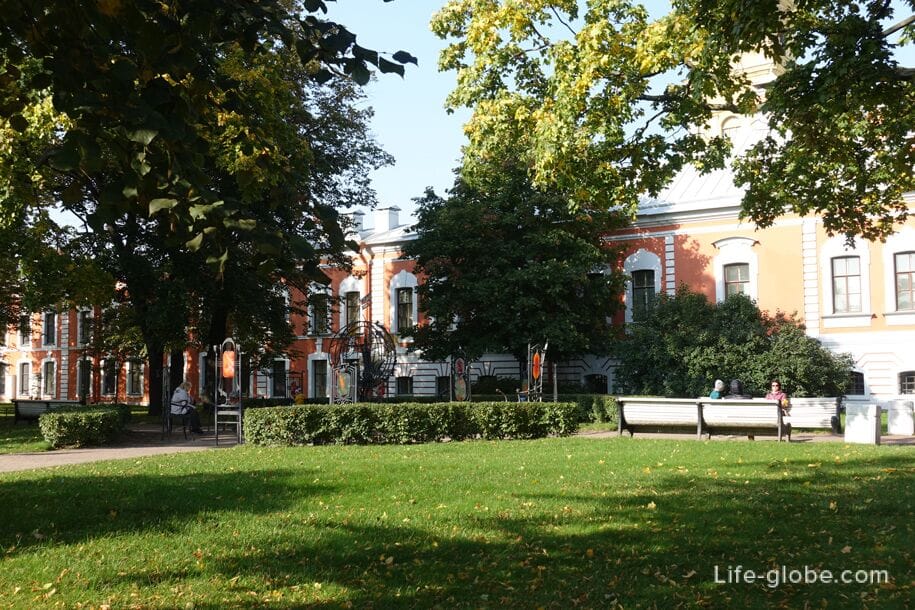


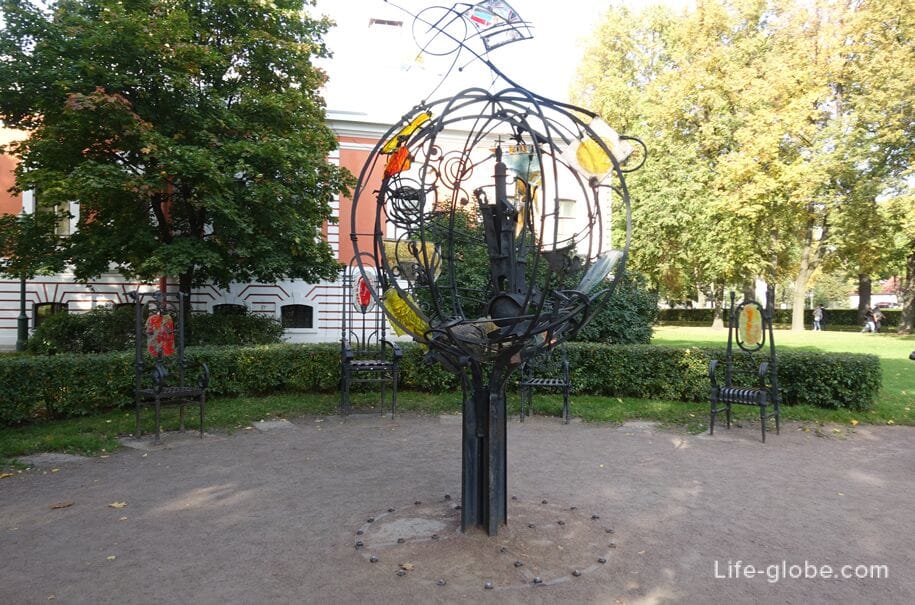
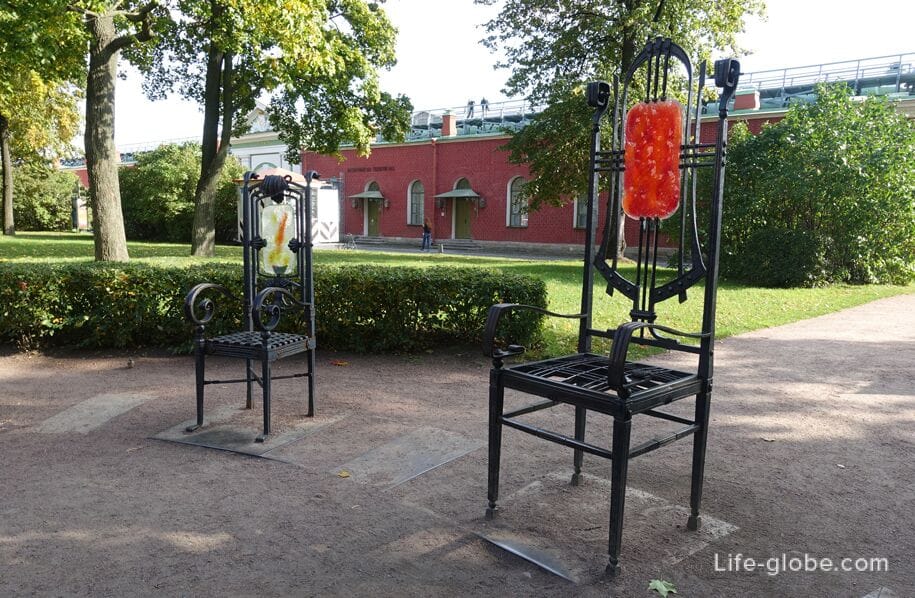
The entrance to the territory of the Peter and Paul Fortress is free (free of charge).
The opening hours of the fortress, as well as the holding of various holidays, festivals and mass events in the fortress can be specified on the website of the State Museum of the History of St. Petersburg: spbmuseum.
The passage of transport to the territory of the fortress is limited, so if you are by car, then you need to leave it outside the territory of Hare Island.
The island is washed by the waters of the Neva River on the south side, and by the Kronverk Strait on the north, east and west sides.
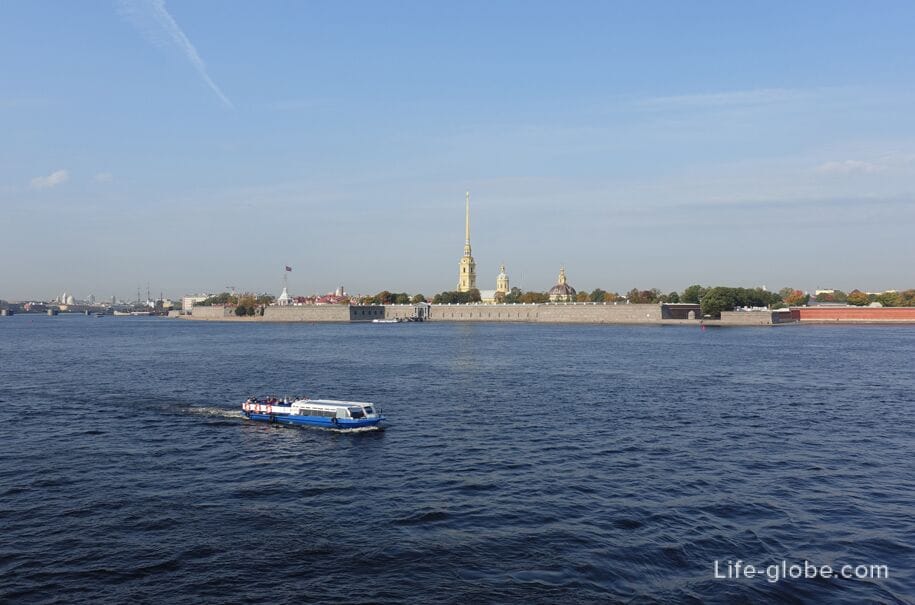
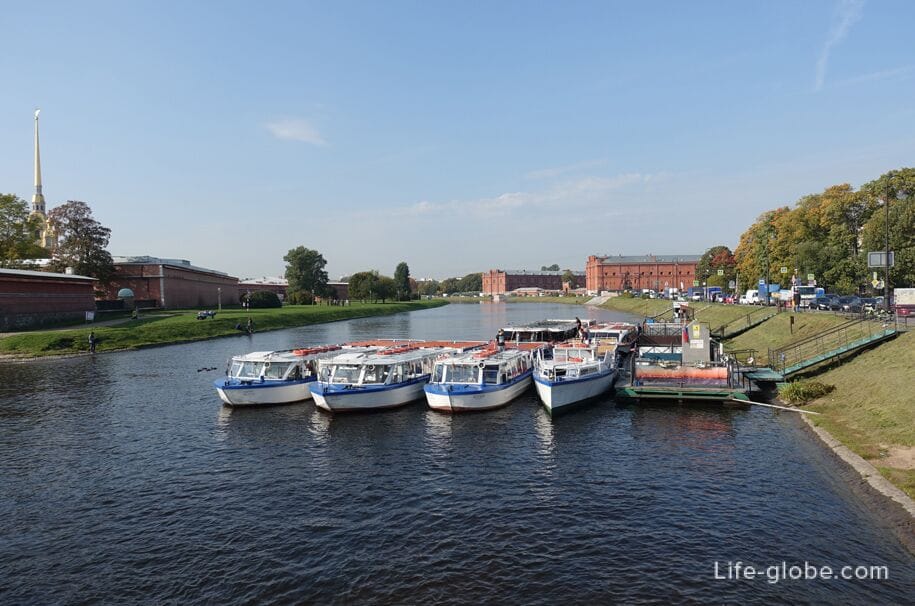
From the Neva side, you can get to the fortress through the Nevsky Gate, to which excursion boats and boats dock.
Two bridges over the Kronverk Strait lead to the island: Ioannovsky and Kronverksky. Bridges connect Kronverkskaya Embankment with Hare Island.
From the very center of St. Petersburg, you can easily walk from the Palace Embankment, first along Troitsky, and then along Ioannovsky bridges.

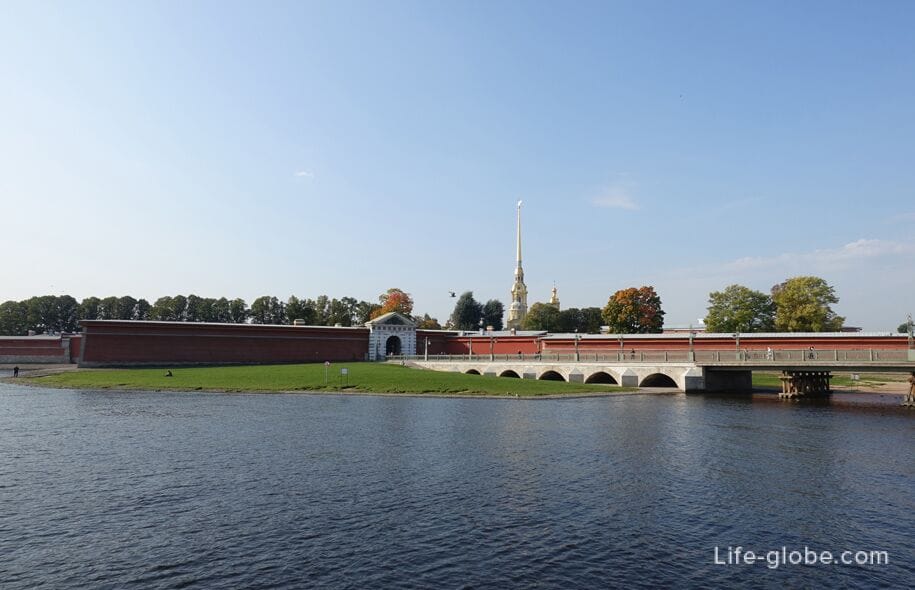
Nearest metro stations: "Gorkovskaya" and "Sportivnaya".
You can also visit the Peter and Paul Fortress with one of the excursions

All accommodation facilities in St. Petersburg, including in the city center and near the Peter and Paul Fortress, can be viewed and booked here